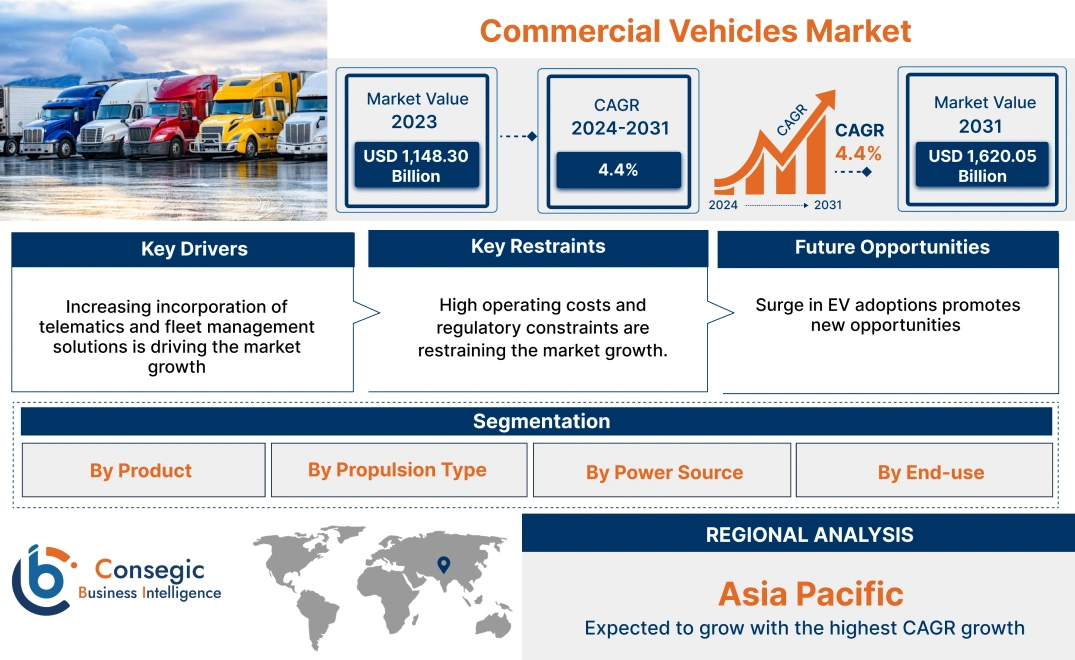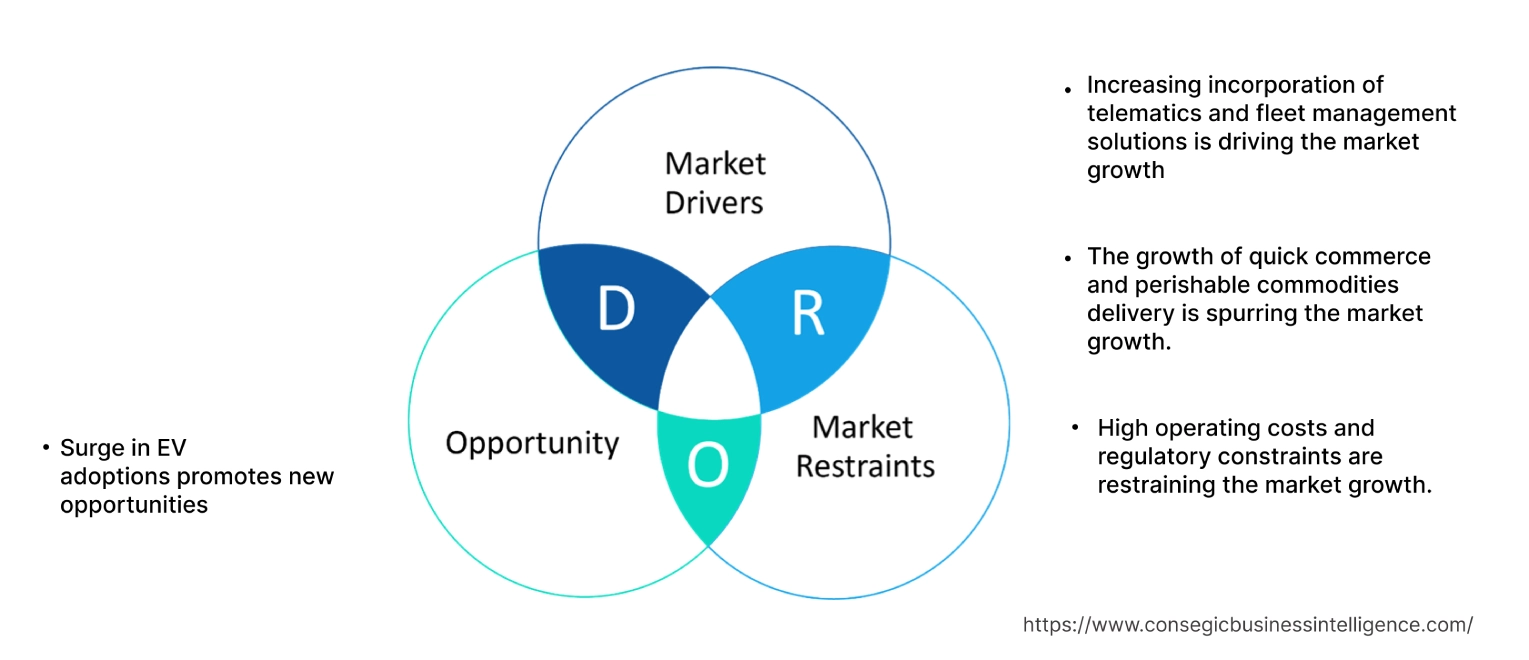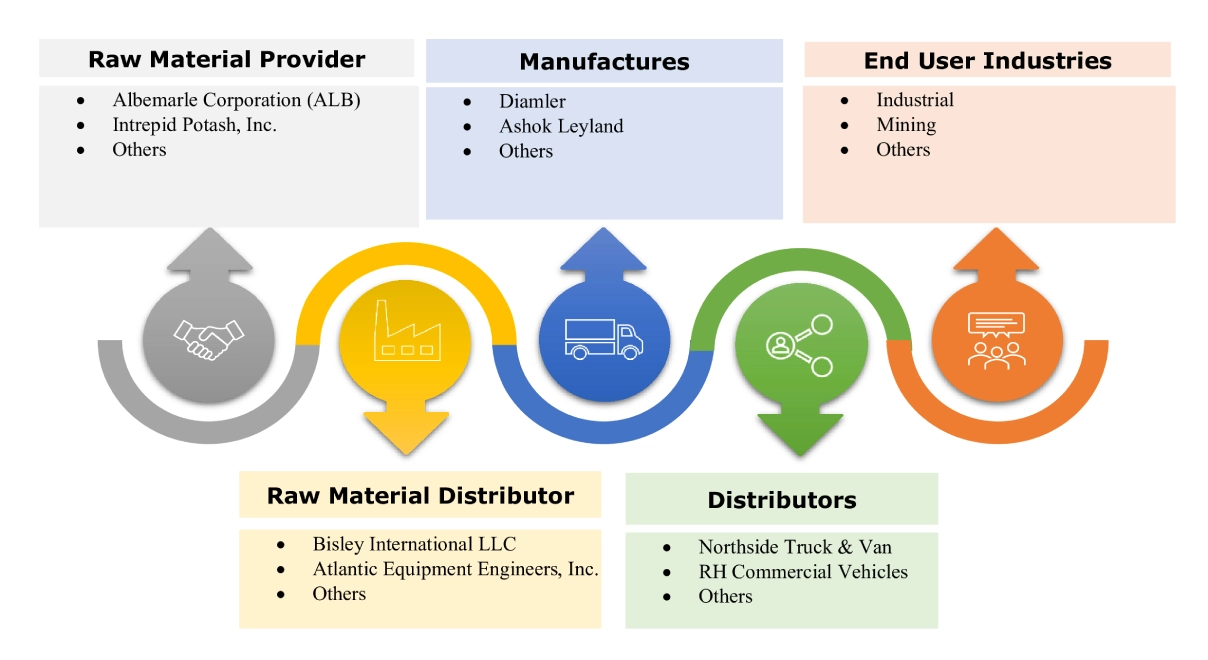- Summary
- Table Of Content
- Methodology
Commercial Vehicles Market Size:
Commercial Vehicles Market size is estimated to reach over USD 1,620.05 Billion by 2031 from a value of USD 1,148.30 Billion in 2023 and is projected to grow by USD 1,179.03 Billion in 2024, growing at a CAGR of 4.4% from 2024 to 2031.
Commercial Vehicles Market Scope & Overview:
Commercial vehicles refer to the vehicles employed for the transport of goods, materials, and people. These vehicles are utilized for commercial purposes rather than personal use. It includes a wide range of vehicles, varying in size, function, and usage. Additionally, the primary factors driving progress in the commercial vehicles market include progress in global investments for mining, logistics, manufacturing industries, and others that require vehicles for the transportation of goods, materials, and people. Moreover, industrial expansion and the increasing adoption of electric-powered vehicles in the transportation sector are a few of the prime factors expected to drive the evolution of vehicles during the forecast period. They are primarily used in several industries including healthcare, automotive, electronics, and others.
Commercial Vehicles Market Insights:
Key Drivers:
Increasing incorporation of telematics and fleet management solutions is driving the market growth
The growing adoption of telematics and fleet management systems is driving the market. These advanced technologies provide fleet operators with real-time data on vehicle performance, location, driver behavior, and maintenance needs. This data-driven intelligence helps streamline operations, minimize downtime, and boost overall fleet efficiency. Additionally, telematics and fleet management systems significantly enhance safety by tracking driver actions, promoting preventive maintenance, and optimizing routes. As industries increasingly focus on safety and compliance with regulations, the implementation of these solutions becomes essential. Moreover, the combination of telematics with the push for sustainability is fueling commercial vehicle market expansion. By improving route planning, cutting fuel usage, and lowering emissions, telematics supports more eco-friendly and cost-efficient operations.
Thus, the incorporation of fleet management and telematics has improved the overall productivity of commercial vehicles.
The growth of quick commerce and perishable commodities delivery is spurring the market growth.
The commercial vehicles market growth for quick commerce and perishable commodities is driving the market. As more consumers turn to online platforms for purchasing groceries and perishable commodities, the need for effective and dependable delivery services has surged. CVs are essential in fulfilling this surge by ensuring the timely and secure transportation of these delicate items. The perishable category necessitates specialized vehicles with temperature-sensitive features to preserve the freshness and quality of products during transport. Vehicles built for cold chain logistics, equipped with refrigeration systems, allow for the transportation of items such as fresh produce, flowers, dairy products, baked goods, and pharmaceuticals. This growing trend highlights the increasing demand for adaptable, well-equipped vehicles that can navigate urban areas, accommodate different load amounts, and meet strict delivery deadlines.
- In FY 2022-23, the Government e-marketplace recorded its highest GMV of USD 2011 Billion. GeM has reached a collective GMV of more than USD 72 Billion approximately since the beginning. GeM has facilitated savings worth more than USD 4.8 Billion from its beginning.
As a result, the commercial vehicle market is experiencing progress due to its crucial role in enabling the efficient and smooth delivery of online groceries and perishable goods directly to consumer homes.
Key Restraints :
High operating costs and regulatory constraints are restraining the market growth.
Rising fuel prices, repair costs, and maintenance are major restraints, impacting operations and profitability. Shortage of critical components such as semiconductors, can delay commercial vehicle production. Moreover, fluctuation in prices associated with adopting advanced technology such as electric drivetrains, telematics, and autonomous driving systems can be a barrier. The lack of specificity in guidelines may limit an association's efficiency in production, not only concerning cost but also flexibility in operation.
Thus, the commercial vehicles market analysis states that the high operation costs and lack of specific regulations are hindering market development.
Future Opportunities :
Surge in EV adoptions promotes new opportunities
Rising adoption of electric vehicles, significant investments in EV fleets, public charging infrastructure, battery charging stations, and battery recycling businesses are witnessing significant development. These sectors provide diverse revenue streams, from charge-per-use systems at public stations to battery swapping. EV supports government initiatives to eliminate carbon emissions from vehicles.
- In 2024, electric scooter manufacturer Ather Energy reached unicorn status, with its valuation rising from USD 750 million in May 2022 to USD 1.3 billion. This milestone follows a successful USD 71 million funding round led by the National Investment and Infrastructure Fund.
- PLI certification awarded by the Automotive Research Association of India (ARAI) to Ola after Ola Electric met the criteria of minimum localization of 50% as mandated by the Ministry of Heavy Industries.
The rising EV adoption for commercial usage is projected to promote commercial vehicle market opportunities during the forecast period.
Commercial Vehicles Market Segmental Analysis :
By Product:
Based on the products, the market is segmented into LCVs, buses & coaches, and heavy trucks.
Trends in the Product:
- The light commercial vehicle segment comprises of vans, mini-trucks, and pickups, it is witnessing higher demand due to the rise in quick commerce, perishable deliveries, and last-mile logistics.
- There is an increasing use of heavy vehicles for transporting large quantities of goods for long distances. These trucks' weight is usually around 18.5T to 55 T.
LCVs accounted for the largest revenue share of 56.22% of the total commercial vehicles market share in the year 2023.
- LCVs are financially profitable solutions for the transport industry for both people and goods. LCVs reduce carbon emissions and have a number of tax benefits. These vehicles are quite active and adaptable according to the needs of both passengers and cargo. They are also cost-effective options, which is expected to drive the segment's expansion.
- Increase in e-commerce and delivery services dominated the overall online market. The growing lightweight CVs market trend for efficient urban logistics and transportation solutions has improved the importance of LCVs, particularly vans and pickups.
- In July 2024, the UK's vehicle remarketing business BCA reported the highest sale for LCVs.
- Hence, the rising surge in e-commerce and delivery services has led to the adoption of light commercial vehicles.
Heavy trucks are expected to witness significant CAGR growth during the forecast period.
- Heavy trucks are built for carrying heavy loads and performing tough tasks in industries such as transportation, mining, and construction.
- Heavy trucks are known for their versatility and robust construction. Heavy trucks streamline the loading process and unloading process, saving valuable time. Equipped with enhanced cooling systems, they are built to handle significant loads. These trucks are often integrated with advanced equipment to ensure the smooth handling of heavy payloads.
- In 2024, Volvo Eicher CVs signed its first contract with Baidyanath LNG Private for the arrangement of 500 LNG trucks that would help in decreasing carbon emissions and scaling up the LNG corridor in India. The project is performed with the collaboration of the Union minister for road transport and highways.
- In 2023, Ample announced battery-swappable last-mile delivery trucks in collaboration with Mitsubishi Fuso from Japan. The start-up has also planned a different type of swapping station for the truck.
- Hence, heavy-duty vehicles can transport heavy-weight and large goods which makes it essential for the commercial industry.
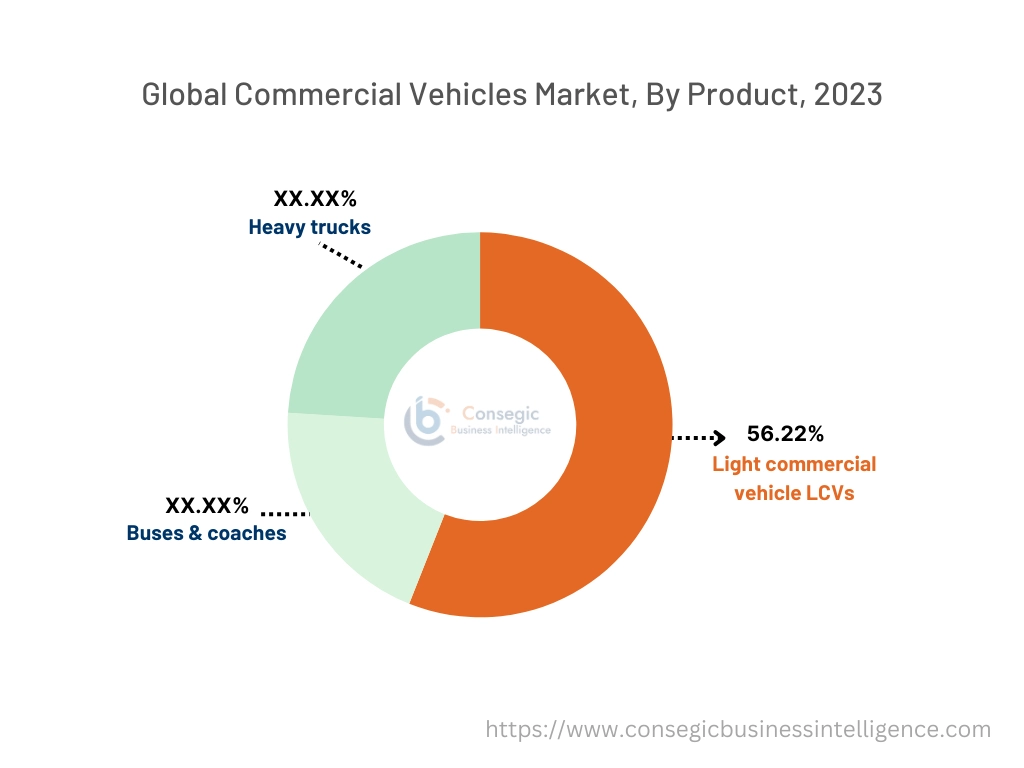
By Propulsion Type:
Based on the propulsion type, the market is divided mainly into I.C. engine, and electric.
Trends in the Propulsion Type:
- The growing trend of using electric vehicles over petrol vehicles is driven by several factors, including cost efficiency, reduction in air pollution levels, and environmental benefits.
- Hybrid vehicles which comprise both I.C. technology as well as electric power offer efficient and reduced emissions compared to conventional vehicles.
The I.C. engine segment accounted for the largest revenue in the year 2023.
- I.C. (Internal Combustion) engine is a heat engine where fuel combustion occurs within the engine, converting chemical energy into mechanical power. It is widely used for efficient power usage.
- In 2024, Cummins Inc. unveiled its latest diesel engine technology, the diesel X15, as part of the Cummins HELM 15-liter fuel-agnostic platform. This new engine was designed to meet U.S. EPA and CARB 2027 regulations, with the latest environmental standards.
- Thus, the rising advancement in I.C. engines is projected to boost the commercial vehicles market growth.
The electric segment is expected to witness a significant CAGR during the forecast period.
- The electric segment refers to electric vehicles powered by electric motors, using energy stored in batteries rather than traditional internal combustion engines. These vehicles are valued because of lower operational costs and reduced emissions.
- The constant support from government policies and regulations is driving the adoption of EVs. Financial incentives such as tax exemptions and credits are being offered to consumers making it more affordable.
- The government of Maharashtra, India is providing a subsidy of USD 298 for electric two-wheelers and USD 357 for electric three-wheelers with no registration fee and zero road taxes and up to USD 2900 for electric four-wheelers.
- Euler Motors is set to launch the small commercial vehicle, unveiling strategies to take off its 4-wheeler electric vehicle with a payload capacity of over 1 ton. The main objective is to cater to the increasing demand for cost-effective and high-performance transportation solutions for both inter-city and intra-city operations.
- Thus, as per the analysis, there is a growing adoption of electric commercial vehicles across various industries, which is projected to boost the electric segment during the forecast period.
By Power Source:
This market is segmented into gasoline, diesel, HEV / PHEV, battery electric vehicle (BEV), fuel cell vehicle, and LPG & natural gas.
Trends in the Power Source:
- The diesel segment is experiencing a rise in demand for transportation across various industries including mining, e-commerce, and others. This demand is expected to continue increasing in the forecasted period.
- Hydrogen vehicles provide an effective solution to the challenges of urban logistics. The solution includes quick refueling time, good performance, and absence of pollutant emissions offering additional benefits over electric vehicle technology.
The diesel segment in commercial vehicles accounted for the largest share in the year 2023.
- Diesel engine holds a prominent share due to the availability of several fuel stations supporting diesel engines, higher torque, and efficiency for long-haul transportation, making it a preferred choice for transportation, industrial, and mining operations.
- For instance, Hyundai the nation's second-largest automaker, remains resolute in its commitment. The success of its diesel variants and its drive to stay competitive have positioned Hyundai as a competitor.
- The diesel segment's dominance is driven by its efficiency, availability of fuel stations, and continuous progress in transportation demand across various sectors.
- Hence, as per the analysis, the need for high torque and long-haul transportation is driving the commercial vehicles market demand.
The LPG & natural gas segment is expected to show significant growth during the forecast period.
- The market for LPG and natural gas vehicles is expected to grow due to increasing environmental issues, higher fuel prices, and the stress on energy diversification. Important advancements in natural gas and LPG vehicle technologies have been made in current years, including safety features, engine efficiency, and fuel storage.
- The regular improvements have increased the affordability of natural gas and LPG vehicles in terms of performance and reliability. As the world moves toward sustainable energy, natural gas, and LPG vehicles are likely to continue important, mostly in areas with underdeveloped electric vehicle infrastructure sources.
- For instance, Asia-Pacific is set to emerge as the growing market for natural gas and LPG vehicles worldwide, mainly driven by the growing demand in India.
- Therefore, as per the analysis, the increasing advancement related to LPG vehicles is anticipated to drive the market during the forecast period.
By End Use:
Based on the end use, the market is segmented into industrial, mining, construction, transportation, and others.
Trends in the End Use:
- The evolution of the market can be attributed to the rising need for large wheel loaders (≥500HP) retaining for building construction, mining, bridge construction, and road, and other applications across the global level.
The transportation segment accounted for the largest revenue in the year 2023.
- They are widely used for vital freight transportation as well as passenger transportation.
- The rising need for effective urban logistics and transportation has significantly increased the trend for commercial vehicles, particularly vans and pickups.
- The Union government has approved 650 buses for Pimpri-Chinchwad and Pune. Out of 650 buses, 200 are AC buses. The purchase of buses including AC buses was made under the public-private partnership model.
- Therefore, according to the analysis, the growing utilization of buses for transportation applications is proliferating the development of the commercial vehicles market trends.
The industrial segment is expected to show significant growth during the forecast period.
- Commercial vehicle is often used for industrial applications during activities involving production, manufacturing, or processing of goods in factories or on a large scale.
- It boosts efficiency by streamlining logistics, reducing operational costs, enhancing productivity through timely deliveries, and providing flexibility for various transportation needs.
- In December 2023, EKA Mobility collaborated with Mitsui & Co., LTD, and VDL Groep to expand its electric commercial vehicle line-up.
- Thus, as per the analysis, the rising development of commercial vehicles in the electric segment for industrial applications is expected to boost the commercial vehicles market during the forecast period.
Regional Analysis:
The regions covered are North America, Europe, Asia Pacific, the Middle East and Africa, and Latin America.
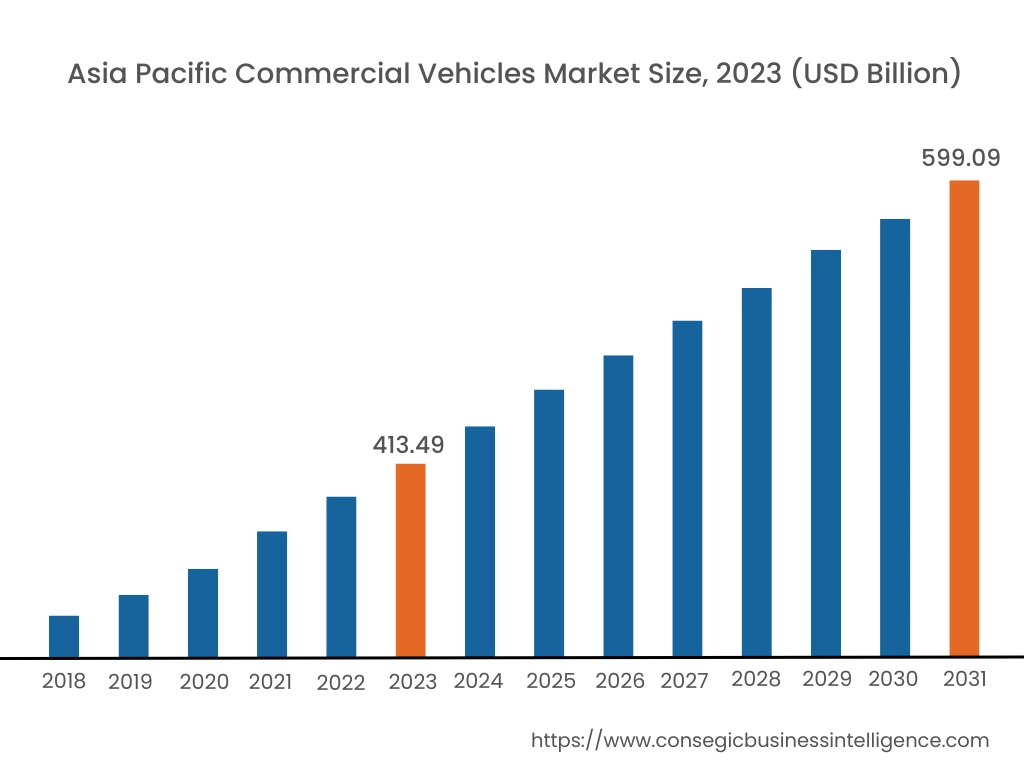
Asia Pacific region was valued at USD 413.49 Billion in 2023. Moreover, it is projected to grow by 425.50 Million in 2024 and reach over USD 599.09 Billion by 2031. Out of this, China accounted for the maximum revenue share of 30.5%.
The rise in urbanization in the Asia-Pacific region leads to an increasing need for natural gas, CNG, and electric vehicles, which increases the progress of the commercial vehicle sectors, in turn driving the commercial vehicles market.
- According to the India Brand Equity Foundation, the Indian government is committed to building a well-connected, shared electric mobility ecosystem which is anticipated to boost the commercial electric vehicle sector. Asian governments are expected to invest USD 26 trillion in infrastructure by 2030.
- In June 2024, Tata Motors introduced the fifth addition to its CNG lineup, the Nexon iCNG at the Bharat Mobility Global Expo 2024. The first turbo-petrol car with a factory-fitted natural gas kit. This innovative offering showcases Tata's commitment to sustainable and efficient transportation solutions.
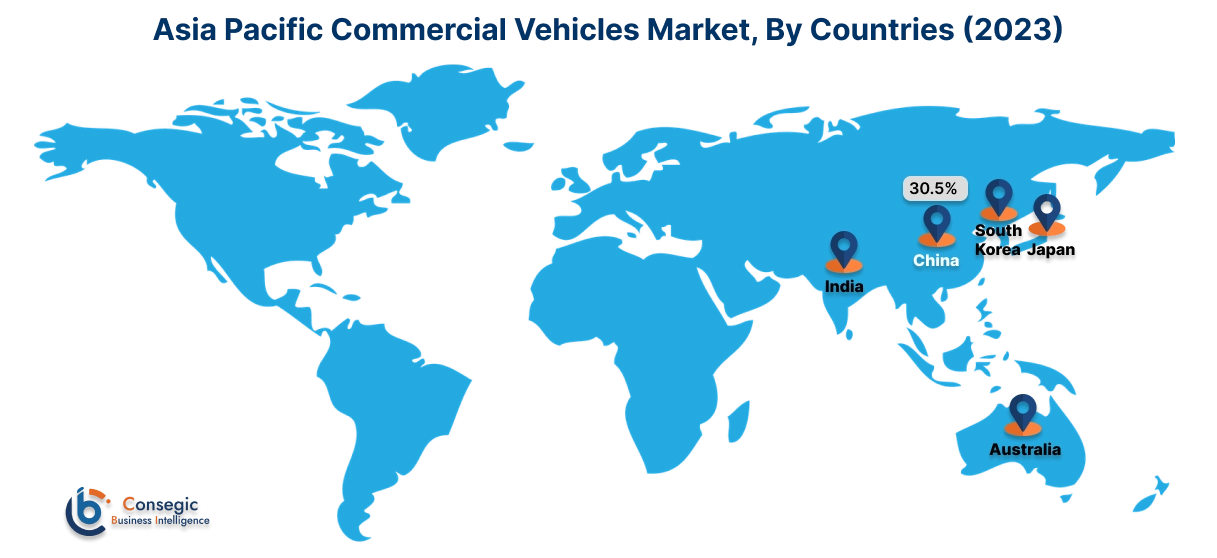
North America is estimated to reach over USD 476.13 Billion by 2031 from a value of USD 336.86 Billion in 2023 and is projected to grow by USD 345.92 billion in 2024. The region's advanced technology infrastructure, strict security standards, and increasing investments in electric vehicles contribute to its dominance. Technological advancements including hybrid engines, LPG, and natural gas are the primary factors driving the market in the region.
The European region is witnessing significant development in commercial vehicles for cargo and transportation applications among others.
- Europe's automotive market saw mixed results in Q1 2024, van sales surged by 12.6% with strong performances in key markets like Italy and Germany.
The CV market is in a developing phase in the Middle East and Africa, showcasing a wide variety of vehicles, including heavy trucks, LCVs, and buses. This market is shaped by urbanization, infrastructural advancements, and stringent regulatory mandates for commercial vehicles.
Top Key Players & Market Share Insights:
The commercial vehicles market is highly competitive with major players providing advanced engines to the national and international markets. Key players are adopting several strategies in research and development (R&D), product innovation, and end-user launches to hold a strong position in the commercial vehicles market. Key players in the global commercial vehicle industry include-
- Ashok Leyland (India)
- Volkswagen AG (Germany)
- Bosch Rexroth AG (Germany)
- Toyota Motor Corporation (Japan)
- General Motors (U.S.)
- Daimler (Germany)
- Mahindra and Mahindra (India)
- TATA Motors (India)
- AB Volvo (SE)
- Golden Dragon (CN)
Recent Industry Developments :
Product Launches:
- In May 2024, India's top commercial vehicle manufacturer, Tata Motors improved its e-commerce solutions with the launch of the all-new Ace EV 1000. Considered to convert quick commerce transportation, this zero-emission mini-truck claims an increased payload of 1 ton and supplies a qualified range of 161 km on a single charge.
- In March 2024, Daimler has planned the launch of 14 innovative products for the year 2024, starting with a new segment of rigid heavy-duty trucks, followed by trucks featuring the newly launched Automated Manual Transmission (AMT), and culminating with the announcement of heavy trucks for construction, mining, and industrial applications.
Commercial Vehicles Market Report Insights :
| Report Attributes | Report Details |
| Study Timeline | 2018-2031 |
| Market Size in 2031 | USD 1,620.05 Billion |
| CAGR (2024-2031) | 4.4% |
| By Product |
|
| By Propulsion Type |
|
| By Power Source |
|
| By End-Use |
|
| By Region |
|
| Key Players |
|
| North America | U.S. Canada Mexico |
| Europe | U.K. Germany France Spain Italy Russia Benelux Rest of Europe |
| APAC | China South Korea Japan India Australia ASEAN Rest of Asia-Pacific |
| Middle East and Africa | GCC Turkey South Africa Rest of MEA |
| LATAM | Brazil Argentina Chile Rest of LATAM |
| Report Coverage |
|
Key Questions Answered in the Report
How big is the commercial vehicle market? +
Commercial Vehicles Market size is estimated to reach over USD 1,620.05 Billion by 2031 from a value of USD 1,148.30 Billion in 2023 and is projected to grow by USD 1,179.03 Billion in 2024, growing at a CAGR of 4.4% from 2024 to 2031.
Which is the fastest-growing region in the commercial vehicle market? +
Asia-Pacific is the region experiencing the most rapid growth in the commercial vehicle market.
What specific segmentation details are covered in the commercial vehicle report? +
The commercial vehicle report includes specific segmentation details for propulsion type, power source, end user, and Region.
Who are the major players in the commercial vehicle market? +
The key participants in the commercial vehicle market are Ashok Leyland(India), Volkswagen AG(Germany), Daimler(Germany), Bosch Rexroth AG(Germany), Toyota Motor Corporation(Japan), Mahindra and Mahindra(India), TATA Motors(India), AB Volvo(SE), Golden Dragon(CN), General Motors(U.S.).
